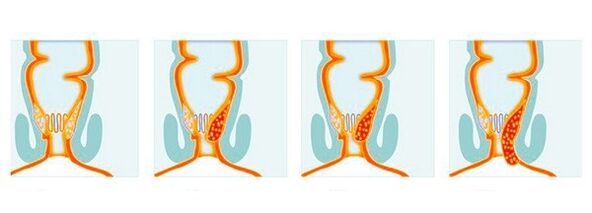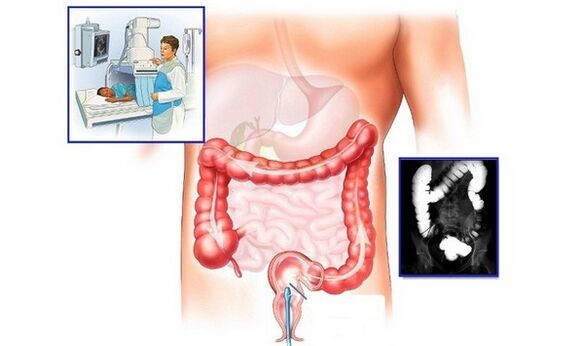
Hemorrhoids are a disease in which there is blood stasis and abnormal changes in the veins of the rectum or in the area around the anus. Such subtle pathologies have no limitations regarding age and gender.
The underlying factor that causes the formation of hemorrhoidal cones is stagnation, which in turn arises from a large number of other predisposing factors.
Pathology is characterized by characteristic symptoms that cannot be ignored by a person. The most specific clinical signs of hemorrhoids are itching and burning in the anal area, rectal bleeding, and severe pain in the perianal area.
The clinic will be able to determine an accurate diagnosis based on physical examination, but in addition, laboratory and instrumental examinations may be required.
Treatment of hemorrhoids directly depends on the severity of the disease, which is why it can be conservative and surgical.
Because pathology has several types, it is coded with several meanings in the International Classification of Diseases.
Etiology
The main reasons for the appearance of hemorrhoid cones are:
- violation of the function of these organ channels;
- increased arterial blood flow;
- disruption of blood flow from the venous plexus;
- loss of tone of the rectal veins, which leads to their expansion and the appearance of nodes.
In addition, doctors identify a large number of unfavorable factors that cause the above processes, which is why they are usually divided into several groups - pathological and physiological.
The first category of causes of hemorrhoids includes:
- chronic constipation - hardened stools injuring the walls of the rectum and anus;
- severe body intoxication - this includes poisoning with alcoholic beverages, toxic substances and chemicals, as well as low -quality food;
- severe infectious diarrhea;
- malignant tumor formation, more rarely benign in the intestine;
- diseases of the pelvic organs, such as prostatitis or cystitis;
- inflammatory diseases of the digestive system;
- hormonal disorders;
- portal hypertension and liver cirrhosis, as well as other diseases of these organs. The relationship of hemorrhoids with the liver is caused by the presence of normal veins;
- the pathological influence of pathogenic bacteria leading to the development of infection.
In addition to diseases and disorders, the cause of hemorrhoids is not at all related to the presence of one disease or another in the body. Among the physiological factors, should be highlighted:
- lack of physical activity - this occurs against the background of various sources - laziness, severe illness that makes the patient unable to move, as well as certain working conditions where a person has to sit or stand while working;
- overweight;
- poor nutrition - this includes the abuse of fatty, spicy foods, smoked meats, sweets, carbonated beverages, semi -finished products, fast food and other harmful substances. For this reason diet therapy is one of the components of hemorrhoid treatment;
- the use of over-the-counter medications, including laxatives or oral contraceptives;
- improper performance of proctological diagnostic procedures or enemas;
- unconventional sexual choice, i. e. anal sex;
- the influence of prolonged stressful situations;
- doing strenuous physical activity;
- engaged in some sports, in particular, cycling or cycling, equestrian sports and other types of weightlifting;
- excessive drinking and smoking;
- period of childbirth or labor;
- menstruation.
Genetic predisposition plays an important role in the development of this disease. Diagnosing a similar pathology in one of the closest relatives will increase the likelihood of a lump. Knowing this, you can freely prevent the onset of the disease, you just need to follow all the rules of prevention of hemorrhoids.
Welding
Clinically, the disease is:
- acute - this is the first manifestation of hemorrhoids that have never been diagnosed before;
- chronic - characterized by alternating phases that exacerbate symptoms and regress.
Depending on the area of hemorrhoid formation, the pathology of the cavernosa is divided into:
- External hemorrhoids - is as if a lump appears under the skin of the anus, and not under the mucous membrane of the rectum. It is considered the rarest form of the disease;
- internal hemorrhoids are the most common type of pathology in which there is the appearance of vascular cones directly in the anal canal;
- Mixed hemorrhoids - the second most common type of disease, which is characterized by the presence of symptoms of the two forms described above.
In addition, there are types of hemorrhoids, divided by severity:
- mild course - symptoms may not be fully present or expressed to an insignificant degree. Conservative methods occur in therapy;
- medium -severe - differs in the addition of the sensation of pain, which is caused by the increase of the node and its injury by feces. Internal lumps fall off during defecation, after which they adjust. It is possible to get rid of this disease with minimally invasive methods;
- severe - characterized by the expression of signs of hemorrhoids such as bleeding. The jugular vein can fall not only during bowel emptying, but also in other situations that cause an increase in intra-abdominal pressure. In such cases, they can only be adjusted manually. Tactics on how to get rid of hemorrhoids can include minimally invasive procedures and extensive surgery;
- complicated - expressed by an increase in symptoms of the disease, and during diagnosis, the development of complications is often observed, one of which may be thrombosis. However, it should be borne in mind that not in all cases of untimely treatment of hemorrhoids, the consequent formation occurs.

Symptoms
The first signs of hemorrhoids can be so minor that one does not notice them. Early clinical manifestations are considered:
- slight discomfort in the anus;
- mild itching in the anal area;
- pain during defecation;
- swelling of the entrance to the anal canal.
As the disease progresses, the following symptoms of hemorrhoids will begin to manifest:
- severe burning and itching;
- increased pain, which will appear not only during defecation, but also during strenuous walking or long sitting
- the appearance of blood and mucus impurities in the stool. It should be noted that the pathological lump will not mix with the feces, but lie on it;
- prolapse of hemorrhoidal lumps, which cause severe pain;
- redness of the skin of the perianal area;
- rectal bleeding - if in the early stages the signs of hemorrhoids can only manifest themselves in the form of hunting with blood on the toilet tissue or underwear, then with a complicated course, the bleeding can reach the intensity of flow. This is what often makes someone ask for help.
In addition to certain clinical manifestations, the above symptoms of hemorrhoids can be compounded by an increase in body temperature, which indicates the development of inflammatory processes.
Diagnostics
Often when symptoms of the disease occur, one does not know which doctor to contact for hemorrhoids. A proctologist or surgeon is involved in the diagnosis and treatment of hemorrhoids, but for the first consultation, you can contact a therapist. Keep in mind that if a child has symptoms, then it should be immediately shown to a pediatrician, and if a woman is pregnant, they must first consult an obstetrician-gynecologist.
The first stage of diagnosis includes the work of a doctor, which aims to:
- detailed survey of the patient for the first time the signs of hemorrhoids appear - to identify the stage of course of the disease;
- familiarize yourself with the medical history and life history of not only the patient, but also relatives - often this is enough to determine the source of why hemorrhoids appear;
- perform objective examinations aimed at assessing the condition of the perianal area, as well as digital examination of the rectum, which makes it possible to distinguish internal hemorrhoids from external and determine the localization of the lump.
The second stage in determining an accurate diagnosis is laboratory examination, i. e. , general blood tests and coagulograms.
The final part of the diagnosis is an instrumental examination of the patient, which aims to assess how the hemorrhoids look, and provides:
- sigmoidoscopy;
- anoscopy;
- colonoscopy;
- radiography using contrast agents;
- Ultrasound of the abdominal organs.

Only after examining the results of the examination, the doctor devised a tactic on how to cure hemorrhoids in patients.
Treatment
The treatment regimen of the disease will depend on the severity of the disease, but common methods of treating hemorrhoids include:
- use of drugs for local and general effects. In the first case, rectal suppositories, ointments, creams and gels are used, and in the second - tablets to improve blood circulation, strengthen veins and neutralize the corresponding symptoms;
- adherence to a frugal diet - indicated for external and internal hemorrhoids. All recommendations on menus and cooking methods were given by the attending physician;
- minimally invasive techniques to remove hemorrhoids;
- open surgery;
- the use of alternative medicine recipes. This should include the preparation of candles and ointments from natural ingredients at home, as well as decoctions from medicinal herbs and plants, used for ingestion or as microclitter and sitz baths.
Among the minimally invasive methods for treating hemorrhoids, should be highlighted:
- introduction of sclerosing material directly into the node;
- ligation with latex rings;
- infrared and electrocoagulation;
- cryodestruction;
- detachment.
The tactics of removing hemorrhoids will be determined by the degree of pathology.
With the ineffectiveness of conservative methods, as well as in cases of complicated diseases, open surgical operation is indicated - hemorrhoidectomy.
How to treat hemorrhoids in pregnant women and children will be asked by obstetricians-gynecologists and pediatricians.
Possible complications
Ignoring obvious clinical phenomena and late treatment of hemorrhoids often leads to the development of the following consequences:
- admission of secondary infections;
- the spread of inflammatory processes;
- anal sphincter deficiency;
- severe bleeding leading to anemia;
- proctitis and paraproctitis;
- blood clot formation;
- anal fissure.
Prevention and prognosis
To prevent the appearance of hemorrhoids, the following preventive rules must be followed:
- living a healthy and simple lifestyle;
- eat properly and balanced;
- strengthens pelvic and abdominal muscles;
- take medication only as directed by your doctor;
- if possible, avoid physical and emotional stress;
- timely addressing constipation and other pathological causes of hemorrhoids;
- make sure that the weight is within normal limits;
- undergo a complete physical examination on a regular basis.
It is impossible to clearly answer the question of prognosis of hemorrhoids, because the results depend on several factors - the degree and form of course of the disease, age category, time of initiation of treatment of hemorrhoids and patient adherence to all doctor's recommendations.
Often people who have been diagnosed with hemorrhoids ask if it can go away on its own? The doctor's answer will always be negative - the disease will turn into a chronic form.
























